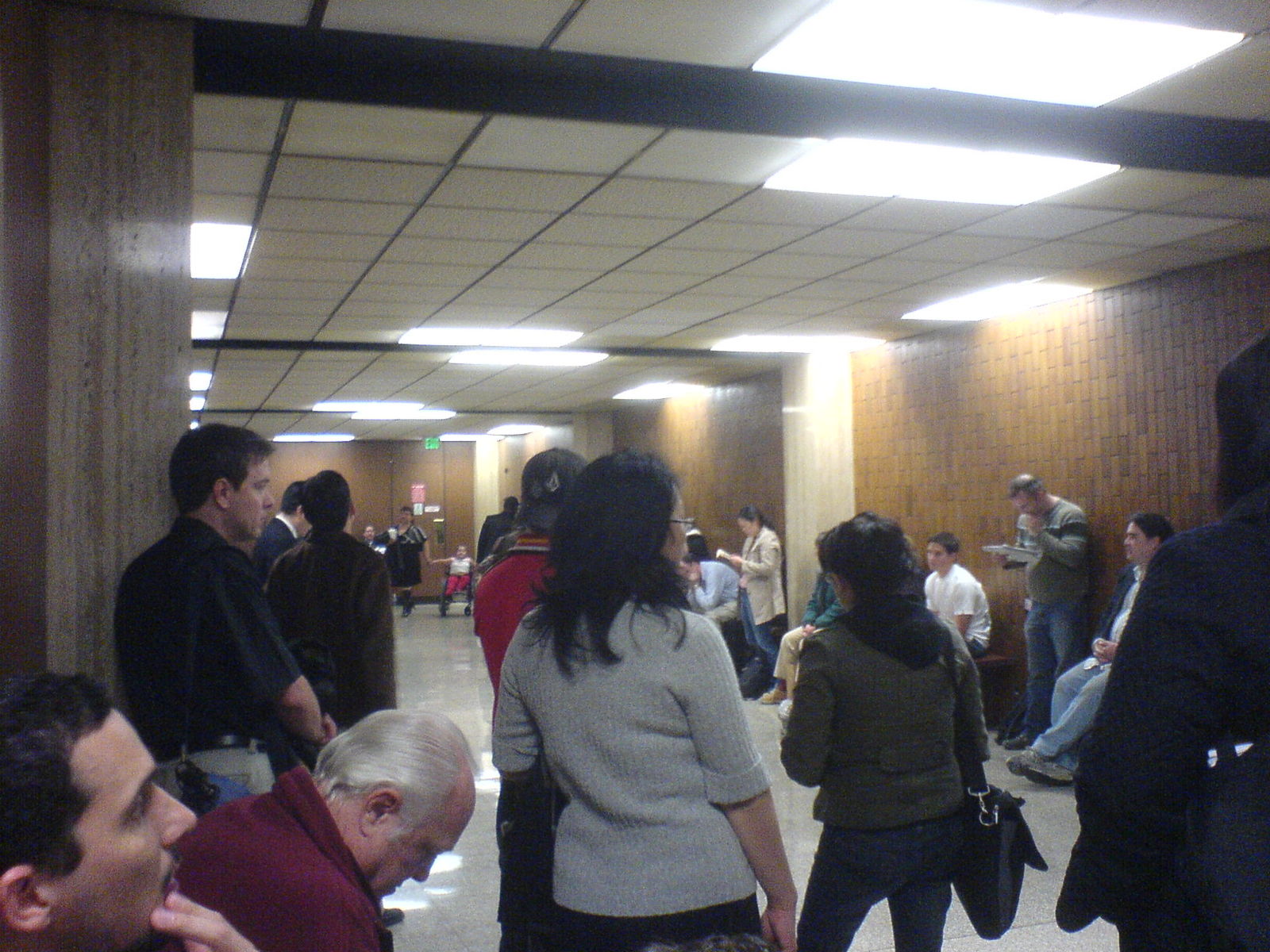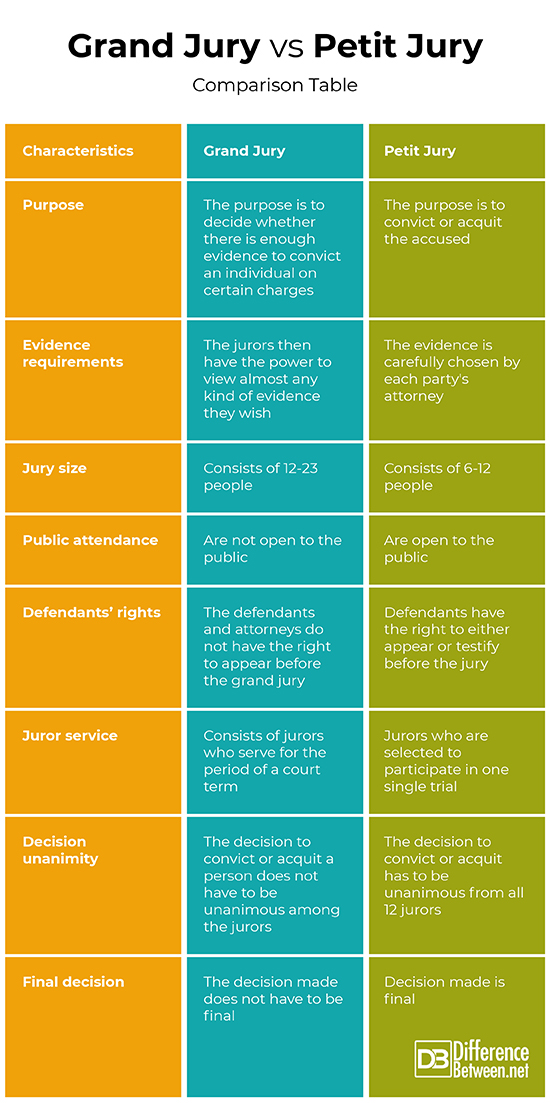Difference Between Grand Jury and Petit Jury
A jury is a group of citizens chosen to hear facts and decide the verdict of a case in a court of law. The jury listens to the evidence during a trial, and then draws inferences, which enables them to make decisions based on the facts from the evidence presented. The jury hence acts as the fact finder, with the judge still holding the major role in the making of the final decision.
There are two major types of juries, the grand jury and the petit jury, which is also known as the trial jury. There is a lot of confusion to the public regarding grand juries and petit juries. Despite the main role of the grand jury and petit jury is to hear evidence and make decisions regarding criminal justice, both have several differences.

What is a Grand Jury?
A grand jury helps prosecutors decide whether a suspect should be charged depending on the evidence presented against him or her. The jury decides whether or not to issue a formal charge or an indictment against a person for felony charges. They consist of up to 23 people. Grand juries work hand in hand with the prosecutor, who explains the law as required at that period to the jurors. The jurors, in this case, have the power to access any evidence they wish and also bring in for interrogation anybody who may help in the case. In most cases, the parties that appear before the grand jury do not have attorneys. The proceedings, in this case, are held in strict confidence so as to encourage witnesses to speak freely and also protect the suspect if the grand jury decides not to bring charges.
The decision made in a grand jury, however, does not mean that the case is closed, as the proceedings are used in the final trial. The decisions made by the grand juries are taken with much seriousness. The prosecutor may, however, ignore or disagree with the decision made by the grand jury.

What is a Petit Jury?
Also referred to as trial jury, they consist of 6-12 people. This kind of a jury decides the facts of a formal trial. A juror selected for a certain trial usually works throughout the trial and can take up to months. A petit jury has no choice in the choice of evidence that they get to see.
Although the decision in a petit jury may be appealed, the trial jury’s decision is final.
Similarities between a grand jury and petit jury
- Both are an important part of law enhancement
- Both ensure the people’s right to a free and fair trial is observed
- Both juries remain independent and impartial
- They both remain uninfluenced by any person
- Grand and petit juries keep statements made in the jury room/court confidential
- Both take directions relating to law from the trial judge
- Both make decisions based on the facts on the case only
Differences between a Grand Jury Vs. Petit Jury
-
Purpose of Grand Jury Vs. Petit Jury
A grand jury is a group of jurors who listen and deal with testimony from the prosecution’s witness, and also a statement about the crime from the prosecutor, hence decide whether there is enough evidence to convict an individual on certain charges. A petit jury, on the other hand, hears testimony from both sides during a criminal trial proceeding, with a purpose of convicting or acquitting a defendant.
-
Evidence requirements
Hearings in the grand jury are less formal, hence the jurors then have the power to view almost any kind of evidence they wish and to interrogate anyone they like. As for the petit jury, the evidence presented is chosen by both parties. In this case, both parties are required to ensure that the evidence is reliable.
-
Jury size for Grand Vs. Petit Jury
The grand jury consists of 12-23 people while the petit jury consists of 6-12 people.
-
Public attendance
Grand jury proceedings are not open to the public and mostly consist of only the witnesses, the jurors, and the prosecutors while petit jury trials are open to the public.
-
Defendants’ rights
In a grand jury, the defendants and attorneys do not have the right to appear before the grand jury while in a petite jury defendants have the right to either appear or testify before the jury.
-
Juror service
While a grand jury consists of jurors who serve for the period of a court term, petit juries consist of jurors who are selected to participate in one single trial.
-
Decision unanimity
In a grand jury, the decision to convict or acquit a person does not have to be unanimous among the jurors, and 12 votes out of the 23 are required for a conviction. In a petit jury, however, the decision to convict or acquit has to be unanimous from all 12 jurors, and in a case where the juror’s decisions differ, the judge declares either a mistrial or a hung jury.
-
Final decision
A grand jury may be used a test run, meaning that the decision made in grand jury does not have to be final. In a petit trial, however, the decision made is final, ultimately proving the innocence or guilt of an individual. Although it may be appealed, this only happens when sufficient errors are proven in the trial process.
Grand Jury vs. Petit Jury: Comparison Table

Summary of Grand Jury vs. Petit Jury
The role of the juries is important in any society as anyone accused of a crime is innocent until proven guilty. It also enhances people’s right to a free and fair trial. For anyone who is facing criminal charges, it is important to ensure one has a skilled attorney, to ensure the rights are upheld.
- Difference Between Profit Center and Investment Center - July 2, 2022
- Difference Between Anti-Trust and Anti-Competition - June 6, 2022
- Difference Between Stocktaking and Stock Control - June 6, 2022
Search DifferenceBetween.net :
Leave a Response
References :
[0]Smith Barbara. The Freedoms We Lost: Consent and Resistance in Revolutionary America. The New Press Publishers, 2010. https://books.google.co.ke/books?id=xzs5XX-QEL8C&pg=PA27&dq=petit+jury&hl=en&sa=X&ved=0ahUKEwjGpfqDzODeAhWHs4sKHWCnB5o4ChDoAQg1MAM#v=onepage&q=petit%20jury&f=false
[1]Goldstein Howard & Witzel Steven. Grand Jury Practice- Litigation Series. Law Journal Press Publishers, 2018. https://books.google.co.ke/books?id=HP1kZ9aIGAEC&printsec=frontcover&dq=grand+jury&hl=en&sa=X&ved=0ahUKEwie4PzQ5N7eAhWQV8AKHZMoAKMQ6AEILTAB#v=onepage&q=grand%20jury&f=false
[2]Walker Kaisa. The Importance of Jury Service- Spotlight On Civic Action. The Rosen Publishing Group, Inc, 2017. https://books.google.co.ke/books?id=YUpgDwAAQBAJ&printsec=frontcover&dq=Difference+between+grand+jury+and+petit+jury&hl=en&sa=X&ved=0ahUKEwiXtpCB4t7eAhWrLMAKHcpMBusQ6AEIKDAA#v=onepage&q=Difference%20between%20grand%20jury%20and%20petit%20jury&f=false
[3]Image credit: https://www.flickr.com/photos/diversey/23487257956
[4]Image credit: https://commons.wikimedia.org/wiki/File:Jury_duty.jpg
